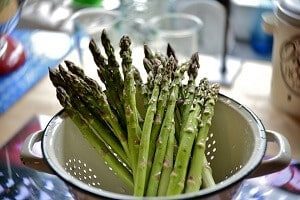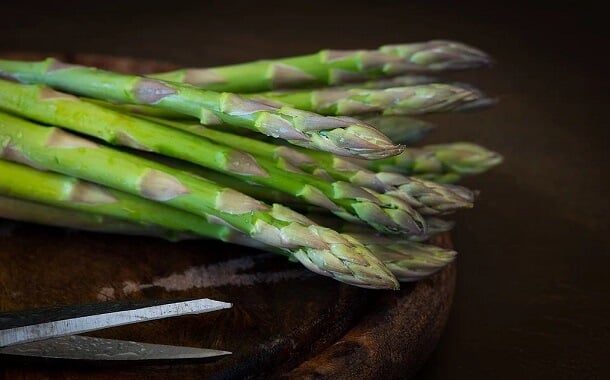How Much Does Asparagus Cost?
Last Updated on October 12, 2023
Written by CPA Alec Pow | Content Reviewed by ![]() CFA Alexander Popinker
CFA Alexander Popinker
Asparagus is considered one of the healthiest vegetables, due to its valuable nutritional properties. The asparagus plant has been used in food since ancient times, also being called the “food of kings”.
Asparagus is a species of herbaceous plant with fleshy roots and leaves that resemble the scales of a fish. Asparagus is native to Europe, North Africa, and West Asia, and is widely grown as a vegetable, for its young shoots, which have a pleasant taste.
Here are some of the benefits of eating asparagus: it detoxifies, has anti-aging properties, is considered an aphrodisiac, protects against cancer, relieves pain and inflammation in the body, prevents osteoporosis, and reduces the risk of heart disease and congenital malformation.
How much does asparagus cost?
The price of asparagus has always been high. In the 19th century, asparagus became the star of fancy dinners. Brillat-Savarin, a renowned French politician of gastronomy, said: “It is certainly very good, but, at all costs, only kings and princes can afford it.” Nowadays, the cost of asparagus depends on where it’s purchased, the time of year, if it’s fresh, and its type.
The asparagus costs can range anywhere from $2 to up to $6 a pound depending on the season or location. If you’re looking for organic asparagus at your local farmers market then be prepared to spend somewhere between $5 and $7 per pound.
For example, if you buy it in the month of August from Walmart, when the production of asparagus is at its peak, you may pay for a bunch somewhere around $3.
At Sam’s Club, you can find two-pound bundles for the cost of $5 or $10 per pound.
On the other hand, the price for canned or frozen asparagus is around $3 to $6 per eight-ounce bag or 14-ounce can.
Asparagus details
Asparagus has been a favorite side dish for centuries. The asparagus can be found in bundles at any grocery store. A bundle typically includes anywhere from 15 to 30 stems and is often labeled with the name of the farm where it was grown on its rubber band packaging.
Asparagus is an edible plant that typically grows around three to five feet tall, with sturdy stems and feathery foliage. The flowers resemble bells in shades of greenish-white or yellow coloration; they can be up to four inches long while the fruit resembles small red berries but it’s poisonous for humans if ingested.
Asparagus is a healthy vegetable that not only tastes good but also has many vitamins and minerals. It contains 93% water and includes nutrients, vitamins B6, A, C, E, and K as well as calcium, magnesium, zinc, dietary fiber, protein, folic acid, iron, phosphorus, potassium, manganese, etc. You won’t find any fat, cholesterol, sodium, or saturated fat when you eat asparagus, so it’s very low in calories.
You might also like our articles about the cost of spinach, zucchini, or cilantro.
There are three varieties of asparagus: green, white, and purple. Green asparagus is the most common, and this is because it bears fruit throughout the year. White asparagus is a seasonal vegetable that bears fruit from mid-March to June. The purple asparagus variety is the rarest. When it is heat-treated it loses its purple color and turns green.
Important things to remember
 Asparagus adapts to a range of climatic and soil conditions but grows best in the Mediterranean and similar areas, such as California and Mexico. The asparagus plant needs light, sandy soils, and natural fertilizer. In the first year, it has no stems. Only in the third year, the stems are good for consumption.
Asparagus adapts to a range of climatic and soil conditions but grows best in the Mediterranean and similar areas, such as California and Mexico. The asparagus plant needs light, sandy soils, and natural fertilizer. In the first year, it has no stems. Only in the third year, the stems are good for consumption.
The ideal asparagus for immediate consumption is to have a light green color, with shades of purple towards the tips. The wooden part of the stem must not exceed 15% of the total length of the asparagus. The stems must be firm, with no soft marks. Thinner stems are tastier and much more tender than thick stems.
Before cooking asparagus, it is good to use a vegetable cleaner to remove the woody parts from the lower half of each shoot. Then the wooden part of the stem can be broken. Thus, it will remain only with the tasty part, which will be prepared evenly.
How you cook it is also very important, in order to preserve its properties and freshness. To maintain its nutritional qualities, it is good to be cooked either on the grill, in the oven, or on steam. Steam for 5 to 8 minutes, and when fried in the pan, the preparation time for the asparagus should be between 3 and 5 minutes.
Asparagus is a delicious vegetable eaten on its own, but it can also be tasted with a sauce or added to various dishes, such as soups, pasta, risotto, fish and seafood dishes, and soufflés. Asparagus has a special taste. Its aromas resemble cauliflower, boiled corn, or eggplant. Purple asparagus tastes sweeter than green and white and has a softer texture.
Per serving, asparagus contains:
- about 288 milligrams of potassium, known for its ability to reduce belly fat;
- 3 grams of fiber that improves digestion;
- 40 calories;
- zero cholesterol or fat, so it can be included in any weight loss diet.
The asparagus plant is very easily perishable, which is why it has to be stored in the refrigerator. It is good to put the stems in a glass of water or a damp paper towel, then cover them with a plastic bag. Asparagus can also be stored in the freezer for about 9 months.
Price of asparagus per kilogram over the last five years
The average price of asparagus per kilogram (kg) over the last five years in the United States has shown some fluctuations.
- In 2018 – The average price was $3.82 per kg
- In 2019 – The price rose to $4.05 per kg
- In 2020 – Prices climbed further to $4.31 per kg
- In 2021 – The average price declined to $3.99 per kg
- In 2022 – Prices rebounded to $4.54 per kg, setting a new 5-year high
Free trade agreements like NAFTA have led to an increase in imports, making it difficult for domestic growers to compete with countries like Mexico and Peru, which have lower production costs. In 2022, the U.S. market saw a decrease in asparagus prices due to the effect of heavy Mexican supply.
In 2023, asparagus wholesale prices climbed as imports from Peru witnessed a 40% decline, leading to a potential increase in pricing due to heightened demand during the summer months.
How can I save money?
Find out if it’s on sale at your local grocery store, and stock up while you can freeze it until needed in the future.
Also, you may find some great deals at the local farmer’s markets.


Leave a Reply
Want to join the discussion?Feel free to contribute!